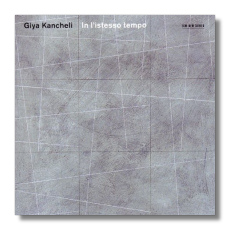
The Internet's Premier Classical Music Source
Related Links
- Kancheli Reviews
- Latest Reviews
- More Reviews
-
By Composer
-
Collections
DVD & Blu-ray
Books
Concert Reviews
Articles/Interviews
Software
Audio
Search Amazon
Recommended Links
Site News
 CD Review
CD Review
Giya Kancheli

- Piano Quartet in l'istesso tempo 1
- Time… and again 2
- V & V 3
1,2 Gidon Kremer, violin
1 Oleg Maisenberg, piano
2 Kremerata Baltica
3 The Bridge Ensemble
ECM New Series 1767 461818-2 DDD 64:40
Every year or so, ECM New Series releases a new CD of music by Giya Kancheli. This is the most recent, but the music itself is not terribly recent, dating from between 1994 and 1997. The previous Kancheli CD contained two pieces – Diplipito and Valse Boston – completed in 1997 and 1996, respectively. The recordings are not new either, although this apparently is their first release on CD. One must ask: what has Kancheli been up to lately? Has he composed himself into a corner? Kancheli's fondness for slow tempos, spare textures, dramatic contrasts in dynamics, and overall Weltschmerz are just as apparent on this new CD as they were on its predecessors. You've got to hand it to the guy: he's got a recognizable style: intimate, cryptic, and unhurried.
In L'istesso tempo ("in the same tempo") might be a motto for his entire output. This piano quartet was commissioned for the ensemble which plays it here, and is dedicated "to my first music teacher." The music elements are simple, and there is much repetition, but that's not to say that the work is naïve. Great, haunted eyes seem to be looking out at the listener. Time… and again was written for Kremer and Maisenberg, who premièred it in London in 1997. The score bears a quotation from Paul's epistle to the Galatians: "Now the things which I write unto you, behold, before God, I lie not." Over the course of some 25 minutes, the violin sings a gloomy lament – sometimes agonizing in intensity - which is punctuated at intervals by harsh interjections from either instrument. Even the booklet note comments that it "seems to last an eternity" – a statement which perhaps sounds less negative in the original German than it does in English! Touchingly, it ends with what might be a very slow and fractured lullaby. While Time… and again hardly opens any doors, there's no doubting the composer's sincerity.
V & V is scored for violin and taped voice with string orchestra. The use of the taped voice at the start and at the end of the work distances the material from the listener, to say nothing of the "live" musicians. Disembodied fragments of folk music – perhaps from Kancheli's native Georgia? – create a haunting effect. Seemingly unconcerned with beautiful tone quality, at least in the traditional sense, Kremer lightly draws his bow over the strings of his violin. The effect is very, very private. The voice and the violin – the "V & V" of the title? – are given a luminous backdrop by the string ensemble.
Despite the three recording dates and two recording venues, the sound quality is consistent from piece to piece. All of the performers have a personal relationship with the music, and there's no reason not to call these performances definitive. The music is something of an acquired taste, but it is worth acquiring.
Copyright © 2005, Raymond Tuttle




















